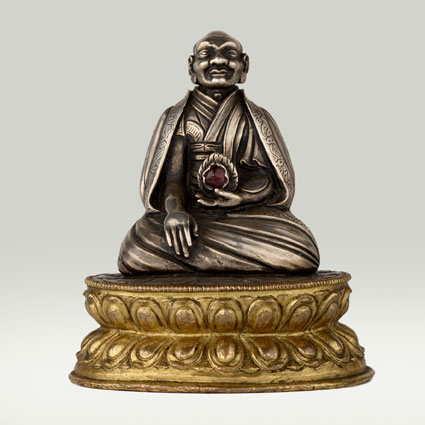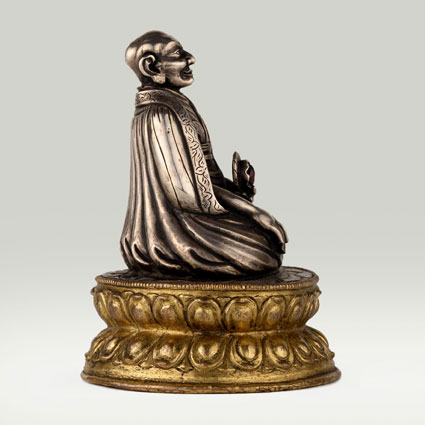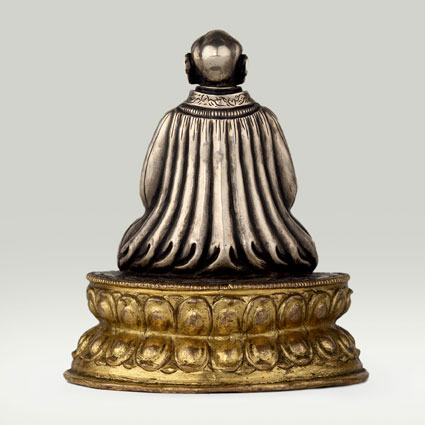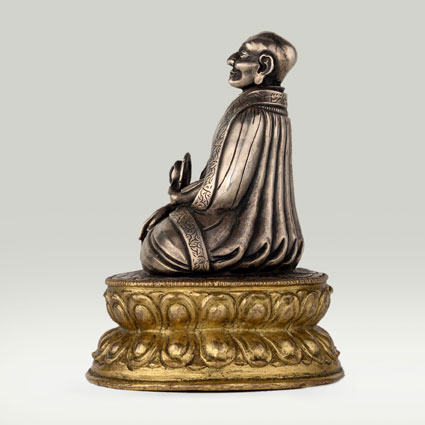Panchen Lama 04 Lobsang Chökyi Gyaltsen (1570-1662)
See it in the Museum
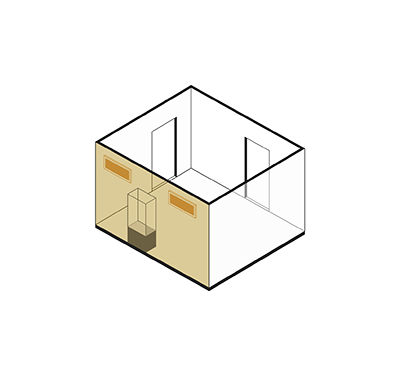
Reception desk
Orientation 3
Display 1

ABS 028
Code: ABS 028
Country: Tibet (central)
Style:
Date: 1650 - 1750
Dimensions in cm WxHxD: 7.4 x 8.8 x 6.4
Materials: Silver pedestal gilt copper
Image made of a sheet of hammered silver alloy; pedestal made of a sheet of hammered and gilt copper.
The bottom of the pedestal is sealed with a sheet of copper decorated with the visvavajra emblem.
The teacher is seated in the diamond attitude (vajraparyankasana) on a single lotus pedestal with an upper beaded border. He rests the right hand on the legs, and holds with the left hand resting in the lap, the “wish-granting jewel” (cintamani) inset with a red granat. The image is clad with monastic garments. The statue is not identified by an inscription.
The fact that the monk is shown seated on a lotus pedestal is an indication this statue was commissioned after his death. In Tibet only deceased monks are represented with lotus pedestal otherwise they are shown seated on cushions or without any pedestal.
The bottom of the pedestal is sealed with a sheet of copper decorated with the visvavajra emblem.
The teacher is seated in the diamond attitude (vajraparyankasana) on a single lotus pedestal with an upper beaded border. He rests the right hand on the legs, and holds with the left hand resting in the lap, the “wish-granting jewel” (cintamani) inset with a red granat. The image is clad with monastic garments. The statue is not identified by an inscription.
The fact that the monk is shown seated on a lotus pedestal is an indication this statue was commissioned after his death. In Tibet only deceased monks are represented with lotus pedestal otherwise they are shown seated on cushions or without any pedestal.
Biography
Lobsang Chökyi Gyaltsen (Tibetan: Blo-bzang Chos-kyi Rgyal-mtshan; ZWPY: Lobsang Qoigyi Gyaicain) (1570–1662) was the fourth Panchen Lama of Tibet, and the first to be accorded this title during his lifetime.
Lobsang Chökyi Gyaltsen was the teacher and close ally of the Fifth Dalai Lama, Lozang Gyatso, called "the Great". The Fifth Dalai Lama gave Lobsang Chökyi Gyaltsen the monastery of Tashilhunpo as a living and declared him to be an incarnation of Amitabha Buddha (Tibetan: Ö-pa-me) and since then every incarnation of Amitabha has been the master of Tashilhunpo.
When Lobsang Chökyi Gyaltsen died in 1662, aged 93, the Fifth Dalai Lama immediately began the tradition of recognising the reincarnation of Panchen Rinpoche. He composed a special prayer asking his master “to return” and ordered the monks of the great monasteries to recite it. He also reserved the title of Panchen (short for Pandita chen po or 'Great Scholar'), which had previously been a courtesy title for all learned lamas, exclusively for him, and this title has continued to be given to his successors and, posthumously, to his predecessors starting with Khedrup Je.
He was a prolific writer and teacher, composing more than three hundred works.
Lobsang Chökyi Gyaltsen (Tibetan: Blo-bzang Chos-kyi Rgyal-mtshan; ZWPY: Lobsang Qoigyi Gyaicain) (1570–1662) was the fourth Panchen Lama of Tibet, and the first to be accorded this title during his lifetime.
Lobsang Chökyi Gyaltsen was the teacher and close ally of the Fifth Dalai Lama, Lozang Gyatso, called "the Great". The Fifth Dalai Lama gave Lobsang Chökyi Gyaltsen the monastery of Tashilhunpo as a living and declared him to be an incarnation of Amitabha Buddha (Tibetan: Ö-pa-me) and since then every incarnation of Amitabha has been the master of Tashilhunpo.
When Lobsang Chökyi Gyaltsen died in 1662, aged 93, the Fifth Dalai Lama immediately began the tradition of recognising the reincarnation of Panchen Rinpoche. He composed a special prayer asking his master “to return” and ordered the monks of the great monasteries to recite it. He also reserved the title of Panchen (short for Pandita chen po or 'Great Scholar'), which had previously been a courtesy title for all learned lamas, exclusively for him, and this title has continued to be given to his successors and, posthumously, to his predecessors starting with Khedrup Je.
He was a prolific writer and teacher, composing more than three hundred works.
Dalaï Lama, 2003. Vaincre la mort, et vivre une vie meilleure - Commentaire d'un poème du 4e Panchen Lama . Plon.
Dinwiddie, Donald (ed.), 2003. Portrait of the Masters: Bronze Sculptures of the Tibetan Buddhist Lineages. Chicago & London: Serindia Publ. Inc. and Oliver Hoare Ltd. Pp. 316-319, pl. 89 - Compare

